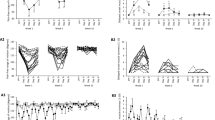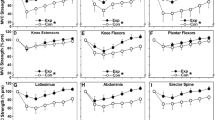Summary
This study characterized changes in the protein composition of human muscle tissue after eccentric exercise. Four subjects performed 70 maximum eccentric, isokinetic actions of the forearm flexors with one arm. The other arm served as control. A biopsy of the biceps muscle of each arm was taken 2 days after exercise when muscles were very sore (mean = 8.0; 1 = normal; 10 = very, very sore), and muscle damage was documented by a mean decrease of 0.2 radians in the relaxed elbow angle. Proteins from the biopsy tissue were solubilized in a high ionic strength buffer containing several proteolytic inhibitors. Protein concentrations of the extracts were determined and identical amounts loaded onto sodium dodecyl sulfate (SIDS) polyacrylamide gels (7.5, 12.5, and 17.5%). Densitometric analysis of the Coomassie brilliant blue stained gels revealed alterations in the amounts of three protein bands in the exercised tissue relative to the control. These changes were in the linear portion of the graph of absorbance versus protein amount. Wilcoxon's signed rank test showed the first two of the following bands to increase significantly in amount (P < 0.062). The average percentage changes [mean (SEM)] for these bands were 63 (21), 39 (5), and 82 (35). The corresponding molecular weights determined from known standards were 76 300 (860), 33 200 (310), and 12 000 (80) daltons, respectively. These changes imply that the increased synthesis, decreased degradation, or some combination thereof, of these three proteins may be necessary for the repair or regeneration response to exercise-induced muscle damage.
Similar content being viewed by others
References
Ananthan J, Goldberg AL, Voellmy R (1986) Abnormal proteins serve as eukaryotic stress signals and trigger the elevation of heat shock genes. Science 232:522–524
Armstrong RB (1984) Mechanisms of exercise-induced delayed onset muscle soreness: a brief review. Med Sci Sports Exerc 16:529–538
Burdon RH (1986) Heat shock and the heat shock proteins. Biochem J 240:313–324
Byrnes WC, Clarkson PM, White JS, Hsieh SS, Fryckman PN, Maughn RJ (1986) Delayed onset muscle soreness following repeated bouts of downhill running. J Appl Physiol 59:710–715
Clarkson PM, Reichsman F (1990) The effect of ethanol on exercise-induced muscle damage. J Stud Alcohol 51:19–23
Clarkson PM, Tremblay I (1988) Exercise-induced muscle damage, repair and adaptation in humans. J Appl Physiol 65:1–6
Ebbeling CB, Clarkson PM (1989) Exercise-induced muscle damage and adaptation. Sports Med 7:207–234
Friden J, Sjostrom M, Ekblom B (1981) A morphological study of delayed muscle soreness. Experientia 37:506–507
Friden J, Sjostrom M, Ekblom B (1983) Myofibrillar damage following intense eccentric exercise in man. Int J Sports Med 4:170–176
Friden J, Kjorell U, Thomell L-E (1984) Delayed muscle soreness and cytoskeletal alterations: an immunocytological study in man. Int J Sports Med 5:15–18
Jones DA, Newham DJ, Clarkson PM (1987) Skeletal muscle stiffness and pain following eccentric exercise of the elbow flexors. Pain 30:233–242
Laemmli UK (1970) Cleavage of structural proteins during the assembly of the head of bacteriophage T4. Nature 227:680–685
Lowry OH, Rosenberg NJ, Farr AL, Randall RJ (1951) Protein measurement with the Folin phenol reagent. J Biol Chem 193:265–275
Nadel ER, Bergh U, Saltin B (1972) Body temperatures during negative work exercise. J Appl Physiol 33:553–556
Newham DJ, McPhail G, Mills KR, Edwards RHT (1983) Ultrastructural changes after concentric and eccentric contractions of human muscle. J Neurol Sci 61:109–122
Padykula HA, Herman E (1955a) Factors affecting the activity of adenosine triphosphatase and other phosphatases as measured by histochemical techniques. J Histochem Cytochem 3:161–169
Padykula HA, Herman E (1955b) The specificity of the histochemical method for adenosine triphosphatase. J Histochem Cytochem 3:170–195
Penny IF, Ferguson-Pryce R (1979) Measurement of autolysis in beef muscle homogenates. Meat Sci 3:121–134
Snyder AC, Lamb RD, Salm CP, Judge MD, Aberle ED, Mills EW (1984) Myofibrillar protein degradation after eccentric exercise. Experientia 40:69–70
Voellmy R, Ahmed A, Schiller P, Bromley P, Rungger D (1985) Isolation and functional analysis of a human 70000-dalton heat shock protein gene segment. Proc Natl Acad Sci USA 82:4949–4953
Author information
Authors and Affiliations
Rights and permissions
About this article
Cite this article
Reichsman, F., Scordilis, S.P., Clarkson, P.M. et al. Muscle protein changes following eccentric exercise in humans. Europ. J. Appl. Physiol. 62, 245–250 (1991). https://doi.org/10.1007/BF00571547
Accepted:
Issue Date:
DOI: https://doi.org/10.1007/BF00571547




